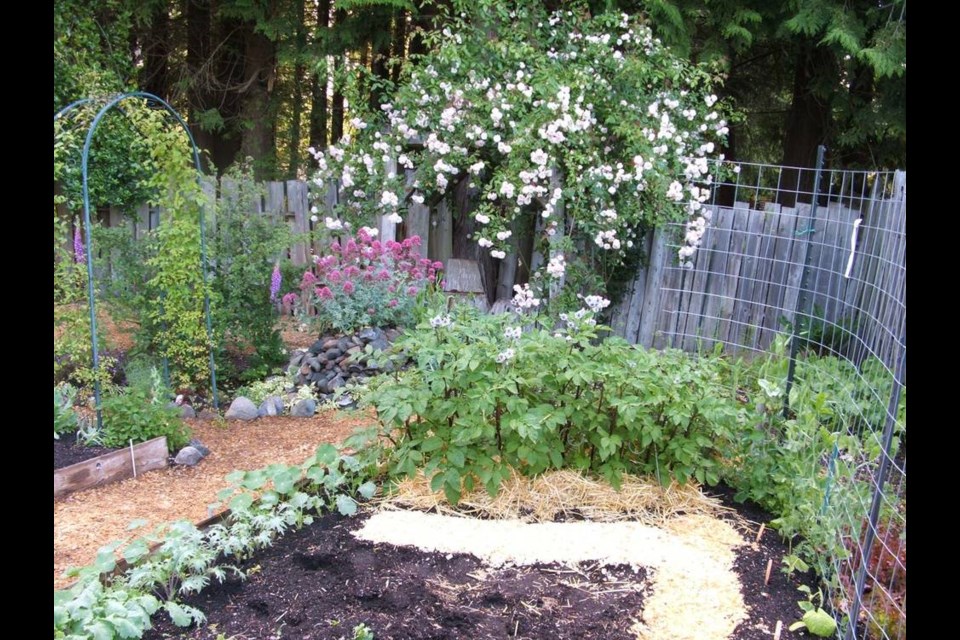With summer well underway, it’s both worthwhile and gratifying to survey what we’ve accomplished in the garden. Last month, I began taking regular breaks from office and garden work to stroll through the garden and observe what’s in bloom, what’s ready to pick, what plantings need water, and where spaces remain to accommodate transplants ready to be settled into beds and plots.
One of the four vegetable plots is full now. The plot is rectangular, with wire fencing supporting cucumbers and sweet peas along one side, beside the back fence. Between the wire fencing and the plot edge I left a narrow space for lettuce and endive transplants.
Between the narrow, far end of the plot and the side fence, a Climbing Cecile Brunner rose put on another fine flower show last month, as a clump of red valerian bloomed out of a rock pile beside the rose.
At that far end I planted potatoes. The Russian Blue planting has created its usual display of showy lavender blue flowers.
Edging the other long side of the plot are nasturtiums and three varieties of kale, seeded directly into the garden this year. Sometimes I start the seeds indoors and transplant. Red Russian is a longstanding favourite kale. Improved Siberian (West Coast Seeds) and Sweet Hardy (Salt Spring Seeds) are more recent happy discoveries.
At the other narrow end of the plot, a young globe artichoke plant grows at one corner and two zucchini plants occupy the rest of the edge.
That left a small rectangular space in the centre, where I seeded carrots and daikon radishes last week. The whole plot is fully packed now, and should yield an abundance of nutritious food — even the cucumbers, which were almost driven into the ground with pounding rains soon after they were transplanted.
Campanula revisited. In a column last month I mentioned a perennial flower that self-sows modestly in my garden to produce clumps of slender stems, 60 to 90 cm tall, bearing large, bell-shaped, blue or white summer flowers. The plant is peach-leaved bellflower (Campanula persicifolia).
A reaction to that item arrived swiftly, from Joe Harvey, a plant geneticist who continues creating new plants. Among them is a “tree peony cross that I made to raise funds for Abkhazi Garden. It is a vigorous single white with black flares, called ‘Abkhazi Princess’.”
Joe’s experience with C. persicifolia has been different from mine: “I have to say that it is a pest in my garden. The problem is the abundant production of seeds. They get into the soil and come up all over and all the time. Mine also have the habit of germinating in pots.
“On the other hand, I have fewer problems with a native campanula, one I call the harebell (Scottish bluebell, C. rotundifolia), of which I have both the blue and white forms. It is excellent for dry rocky places and stone walls.”
I love this kind of feedback. It launches me into new and interesting plant adventures. An observation and suggestion from a plant specialist of Joe Harvey’s stature has a particular value.
Various seed sources for C. rotundifolia can be found on the internet. Plant World Seeds, which I order from most years, lists an astounding 53 Campanula varieties, including two forms of C. rotundifolia.
The Canadian Wildlife Federation (CWF) website has excellent information on this bellflower. There are many common names, — harebell, round-leaved bellflower, Blue Bells of Scotland, and more. It is native to widespread areas through the northern hemisphere, including most of Canada’s open fields, rocky areas, meadows and shorelines.
Each plant produces an abundance of bloom on thick stalks 15 to 45 cm tall. The flowers attract and feed hummingbirds, insect pollinators including bees, and other beneficial insects.
From observations in their own demonstration gardens, the CWF describes this bellflower as “a dainty little plant that could easily be overlooked, except for its profusion of flowers. With rich purple blooms, Campanula rotundifolia catches the eye from June right up to the end of September.”
VHS meeting. The Victoria Horticultural Society is hosting a Zoom meeting on Tuesday, July 6, from 7 to 8:30 p.m. Loree Bohl, author of Fearless Gardening (Timber Press), will speak about “Hardy Plant Choices and Fool-the-Eye Alternatives. Non-members can register for $5.00. To register visit vichortsociety.org.



